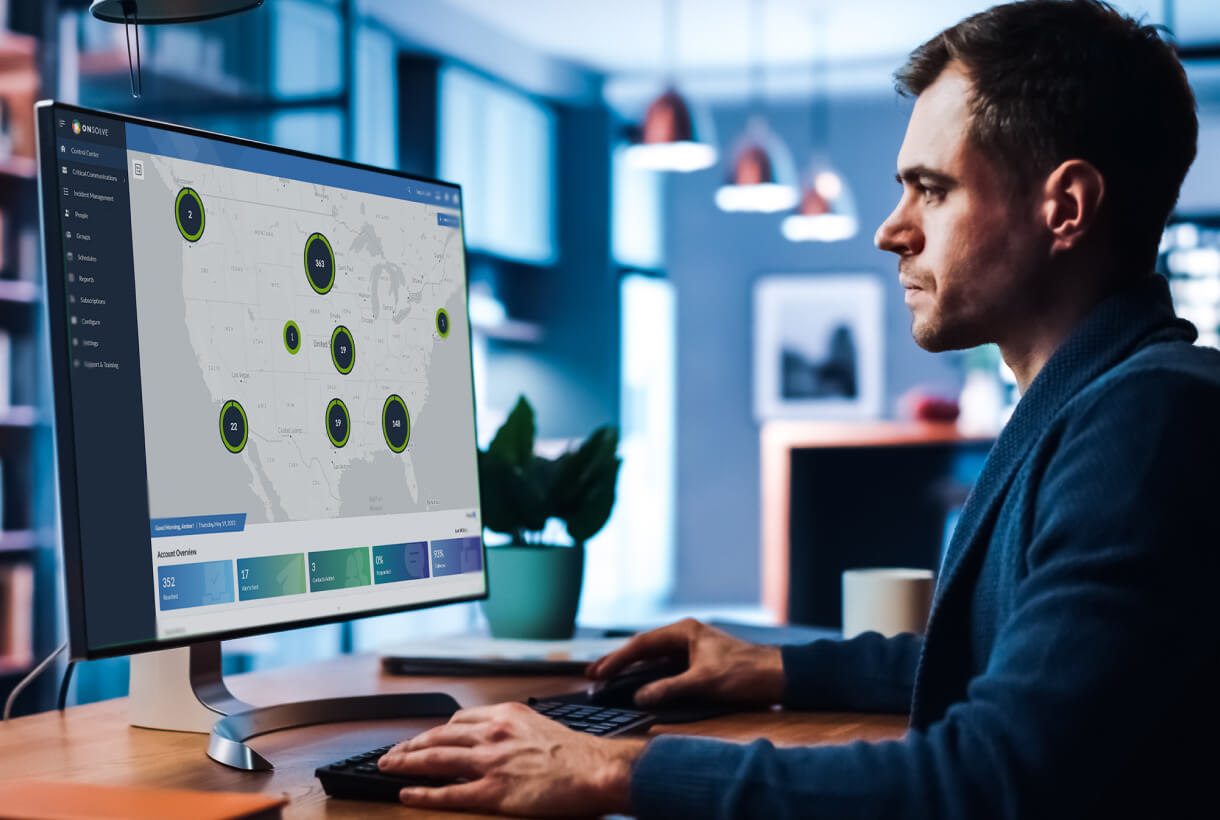More organizations than ever are employing emergency alerting technology as part of their crisis preparedness plans. In the 2024 OnSolve Global Risk Impact Report, executives were asked what type of technologies are currently being used for threat/hazard mitigation. More than half (51%) said “mass notification/communications solution.”
The emergency alerting system (or mass notification system) you choose for your organization can have a large impact on how effectively you can respond to any type of crisis, whether it’s a man-made threat, cyber security breach or natural disaster.
Here are five pillars of a mass notification system that enterprises should consider as they evaluate their existing system or look for a new one.
1. Customization Capabilities
When you send out an alert to a group of stakeholders, they should know immediately who sent it. Effective mass notification systems enable organizations to customize messages with the company logo, for example, so recipients can tell at a glance that the alert is legitimate and should be taken seriously. Customization can also allow organizations to select different formatting or color schemes for emergency alerts and routine organizational messages so stakeholders know whether the message is urgent or not.
Alert systems should allow your organization to target specific groups of employees, such as the IT team, so the right people are notified as soon as possible when an issue arises. Different organizational functions may need slightly different alerting features, so a strong mass notification system should allow you to personalize functionality for different users, such as the security team, management board and business continuity team.
2. Reporting and Analytics
A strong mass notification system should offer detailed reporting and analytics so your organization can meet any legal requirements, increase transparency across departments, and evaluate and improve future business continuity and disaster response plans.
When you send out an alert to stakeholders, it’s important to be able to track who received the alert and who opened it so you have an idea of who might need assistance. The system should be able to provide detailed reporting immediately after an alert is sent, including who received the alerts, so you can create an after-action follow-up plan. Ideally, the system will also enable two-way communication so stakeholders can respond to either confirm that they are safe or say they need help.
Detailed reporting can also be useful for increasing transparency because it allows authorized team members to see what actions have been taken so far in response to the crisis and how they can best proceed.
How It Works: OnSolve Mass Notification
Discover exactly how our mass notification capabilities help organizations keep their people safe and informed. Learn about key features, answers to the most common communications questions and see how fast and easy it is to send an alert.
3. Reliability and Security
If your enterprise alert system is unreliable and unsecure, it will likely create more problems than it solves. A reliable mass notification system should be able to rapidly send out alerts to all relevant stakeholders so they can take immediate action. When a crisis hits, every second can be the difference between life or death, so an unreliable system that breaks down when you need it most is a crisis of its own. An emergency alert system should be able to reach stakeholders anywhere around the world on a variety of communication channels, even in places with limited coverage.
Security is also crucial because alert systems have access to personal contact information, and a breach could jeopardize your organization’s reputation and stakeholder trust. Your mass notification system should offer secure, encrypted messaging with extensive logging and role-based permissions.
4. Geo-Targeting Capabilities
In the case of a localized emergency, your organization may need to alert a group of stakeholders in a specific area. For example, if there is an active shooter in one of your office buildings, the employees who work there are the ones who need to be alerted the moment the threat is made known.
Mass notification systems that enable geo-targeted alerts can reach stakeholders in a specific building or even on a certain floor. You should be able to easily map the desired area or enter the location using a city name or ZIP code. In addition to alerting affected parties, geo-targeted alerting prevents your organization from sending irrelevant alerts to stakeholders in areas unaffected by a crisis.
5. Seamless Integration with APIs and Existing Hardware
Most organizations have a variety of software and applications already in place. A strong mass notification system should allow your organization to easily add alert functionality to your new, legacy or custom-built solutions. Look for a system that can integrate alerts with your existing systems by using the API or command line option.
A platform that doesn’t mesh with your current system could cause duplicate work or result in a chaotic crisis response. Perhaps one of the largest tasks that comes with implementing mass notification software is making sure your contact data is accurate and up to date. A good mass notification system should be able to sync with critical systems, such as business continuity tools and badging systems, and automatically update the master database when employees leave the company or stakeholders are added.
How KnowBe4 Harnesses an Alert System to Keep Employees Safe
KnowBe4, the provider of the world’s largest security awareness training and simulated phishing platform, uses OnSolve Mass Notification to communicate with employees about severe weather and other unpredictable crises.
The Director of Physical Security can quickly send an alert to a specific group of employees who can then take action to stay safe. Employees can also reply to the alert and mark themselves as “safe” or request assistance. Keeping lines of communication with employees open during hurricane season is important for KnowBe4, but the mass notification system also came in handy when a freon leak necessitated an evacuation of three floors of an office building.
The KnowBe4 security team keeps a library of pre-prepared alerts for the most common communications – i.e., the building is closed today due to hazardous road conditions, a power outage has affected the office, etc. This saves time during a crisis. Alerts can be sent on a variety of communication channels, including email, phone, SMS, push notifications, desktop alerts and more, ensuring that stakeholders receive the alert regardless of whether or not they’re at their desk.
Get the Right Message to the Right People
Enterprises rely on effective mass notification technology to rapidly communicate with multiple offices and a variety of stakeholders in numerous ways. Look for a system that can support your team’s needs with customization capabilities, comprehensive reporting and analytics, reliability and security, geo-targeting capabilities, and simple integration with APIs and existing hardware. To learn more, download the brochure How It Works: OnSolve Mass Notification.


